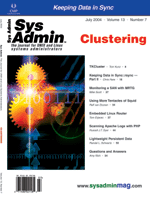 syslog syslog
We recently mailed our annual Readers' Survey to a subset of subscribers.
If you received one, I encourage you to fill it out and return it
to us. We value the feedback from readers. On that note, we received
some comments in response to the coverage of LDAP in our May issue
and, because of space constraints this month, I'm excerpting one
of the letters here. Alf Wachsmann wrote:
While reading the two articles about LDAP in your May 2004 issue
of the Sys Admin magazine I became rather angry: LDAP can
NOT be used securely as an authentication system! If someone is
looking for alternatives for their current system, look at Kerberos
5 (MIT or Heimdal).
Also, NIS is not insecure per se. It is insecure as an authentication
system but has no problems with security as an authorization system
(use "securenets" and block NIS ports on your firewall).
The real shortcoming of LDAP when used for authentication is the
fact that encrypted passwords travel over the wire. Modern authentication
systems, like Kerberos 5, do not do this. LDAP also cannot provide
mutual authentication mechanisms for services. Kerberos has many
more built-in security features like a replay cache or pre-authentication.
Hal Pomeranz, our technical editor, responded as follows:
Given the way the articles turned out, your criticisms are generally
well founded. We had hoped to include information on SASL binding
between LDAP clients and servers, but that did not happen. Once
the client-server communication is fully encrypted and there's strong
authentication between the LDAP client and server, I actually consider
LDAP to be a reasonably secure (though not perfect) authentication
system, but unfortunately that was not the full scenario presented
in the articles. We hope to acquire a follow-up piece to complete
the picture.
That being said, I'm also a big fan of Kerberos for authentication.
What's always been interesting to me has been the perception of
Kerberos as "hard" to do, and yet sites seem to be willing to invest
as much or more effort in converting over to LDAP-based systems
for authentication. I suspect this is because there are a lot of
"canned" NIS to LDAP migration tools out there, so people perceive
that the transition is smoother. Or it could be the lack of a clear
general naming services choice for Kerberos (whither Hesiod?) --
people know that they need to store more than just basic authentication
information, so LDAP seems attractive as a "single source" for all
of their network data. Again, I think it's a perception more than
reality perhaps.
I'd frankly be interested in more Kerberos-related content in
Sys Admin magazine. In fact I'd dearly love somebody to write
an article describing how to authenticate Unix Kerberos clients
to Active Directory servers and have a single login for users across
the Unix and Windows domains.
If you're interested in writing an article for Sys Admin
magazine on Kerberos, LDAP, or some other topic, or simply have
feedback to share, please send your proposals to Rikki Endsley (rendsley@cmp.com)
and your comments to me (aankerholz@cmp.com). We look forward
to hearing from you.
Sincerely yours,
Amber Ankerholz
Editor in Chief | 
